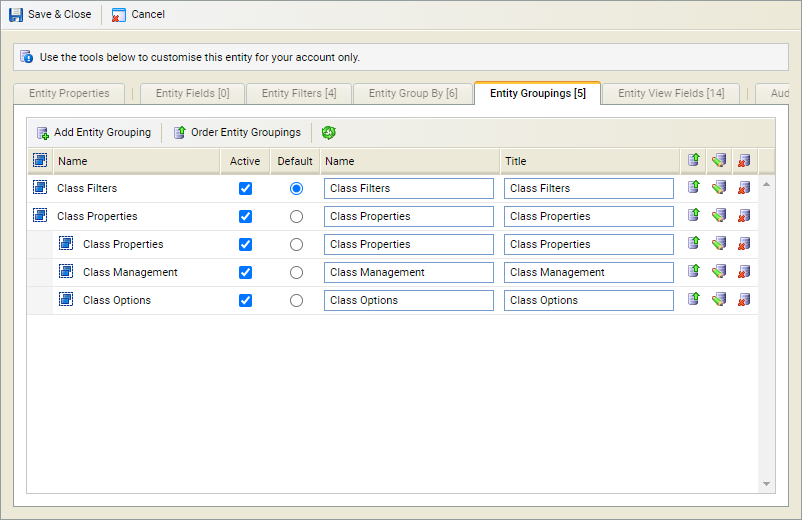Class View
Use the Class View tab in the Curriculum Manager module to manage the classes in your curriculum.
The Curriculum Manager module must be fully configured for the class function to operate as expected.
If you have migrated data from the Teaching Manager module, the Class View tab is populated for you. The detail shown within each class are the details currently held for classes/forms/sets within Teaching Manager.
Classes feed into the Gradebooks module. Students and teachers associated with a class in the Curriculum Manager module are automatically pulled through to the Gradebooks module.
- Open the Curriculum Manager module and select the Class View tab:
- Use the drop downs in the top right of the screen to select the programme and cycle that you want to work with:
-
Use the tools available to display the classes that you want to work with:
- Select Class Properties and use the filters available. Hold Ctrl to select more than one option in a filter.
- Type a search term in the Quick Search Classes field and press enter on your keyboard.
- Use the Group By drop-down in the right of the header to group the classes displayed by a selected property.
- Navigation tools are available at the bottom of the screen.
- Choose to:
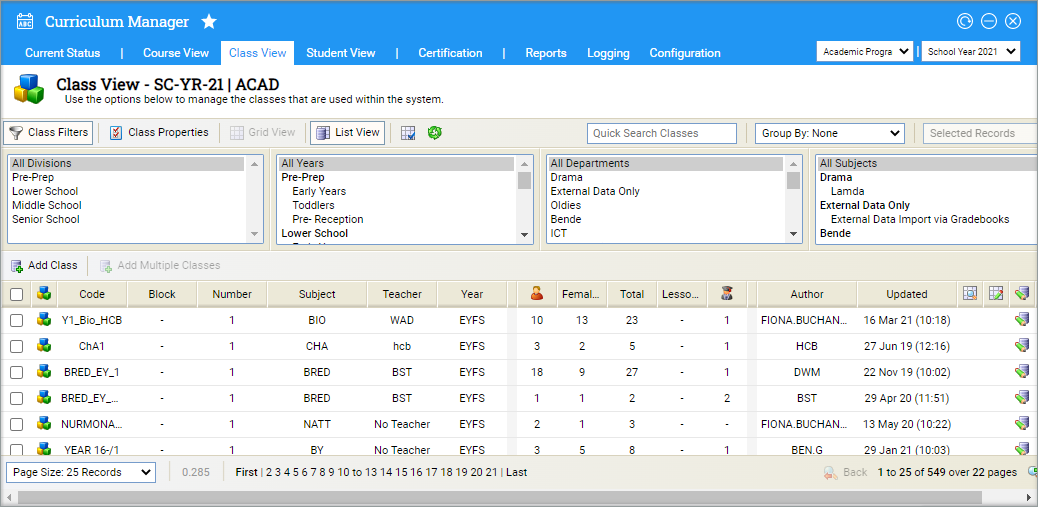
All classes for your selected programme and cycle are displayed with the number of students and teachers within each class shown.
Update Class View entity preferences
Update the entities displayed for classes. For example, choose to display class Codes in the Class View screen grid.
Your entity preferences can also be configured centrally from the Manage Module Entities option.
- Select the table icon in the header to display the Edit Module Entity window:
- The Entity Properties tab displays an overview of your entity preferences.
- The five following tabs hold property details for the entity. A count next to the tab title indicates the number of selections made in the tab.
- The Audit tab lists any amendments that have been made to the entity.
-
In the Entity Properties tab:
- Entity Properties cannot be changed.
- It is not recommended that you make any changes to Export & Import Options.
- Filter Options indicate the number of rows displayed if filters are used for the entity. The example below has 6 rows in the filter:

-
Work through the tabs shown to set details for the entity:
 Entity Fields
Entity Fields
This tab is not currently being used in Class View.
 Entity Filters
Entity Filters
All of the filters that can be used for the entity are listed.
- Use the checkboxes to select the filters that you want to include for the entity:
- Change the Titles used for the filters as required.Your selections determine how filters are displayed for the selected entity:
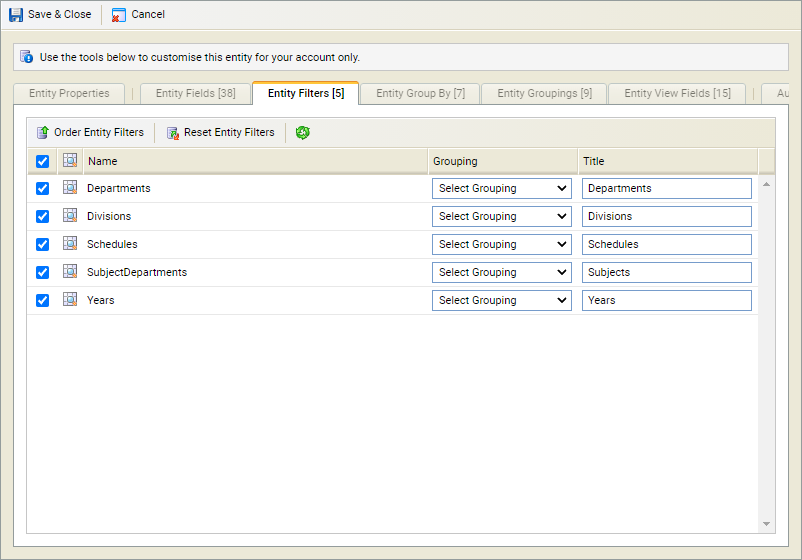

 Entity Group By
Entity Group By
All of the group by selections that can be made for the entity are listed.
- Use the checkboxes to select the group by selections that you want to include for the entity:
- Select a default if required.
-
Change the Labels and Titles as
required:
- The Label name is displayed in the Group By drop-down menu.
- The Title name is displayed in the screen where data is grouped. An example of how your selections are displayed for the selected entity is shown below:
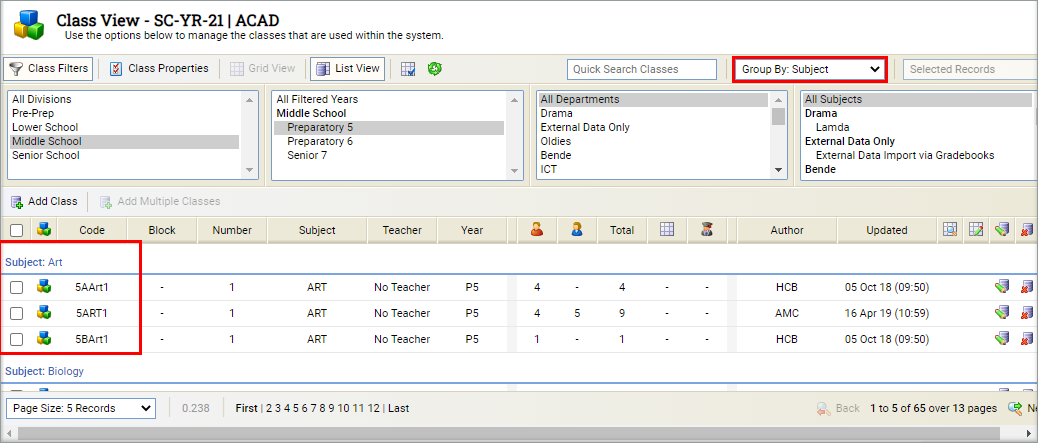

 Entity View Fields
Entity View Fields
All of the information that can viewed for the entity is listed.
Use the checkboxes on the left to select the columns that you want to display:
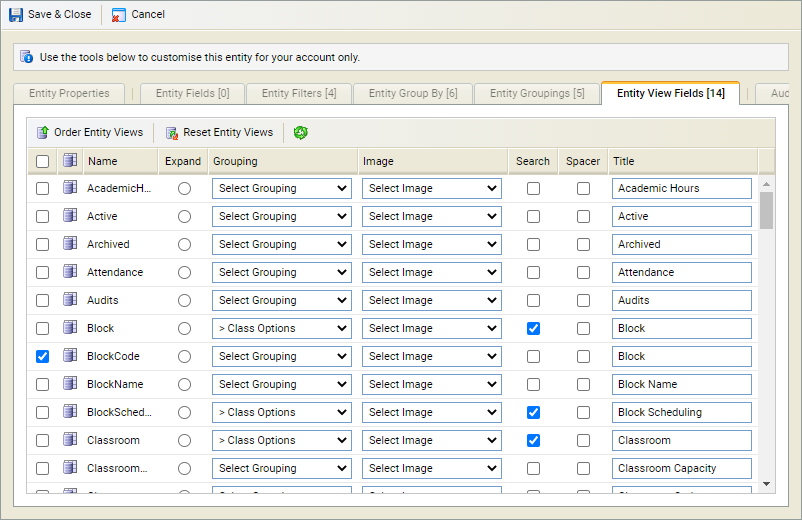
Be aware that the selections made in Manage Module Settings can determine the fields that are displayed regardless of whether they are selected here.
-
Select whether an Image or a Title
are displayed in the header bar for the entity. Either:
-
Use the Select Image drop-down to select an image for the entity. An icon is
used instead of a column title.
or - Enter a Title for the entity and check the box to the left of the Title. This is useful if you want to customise titles to suit you.
-
Use the Select Image drop-down to select an image for the entity. An icon is
used instead of a column title.
- Use the Spacer checkbox to add grey space to the right of columns. This is useful for dividing up the information displayed in the Class View screen.
- Your selections determine the columns displayed for the selected entity:
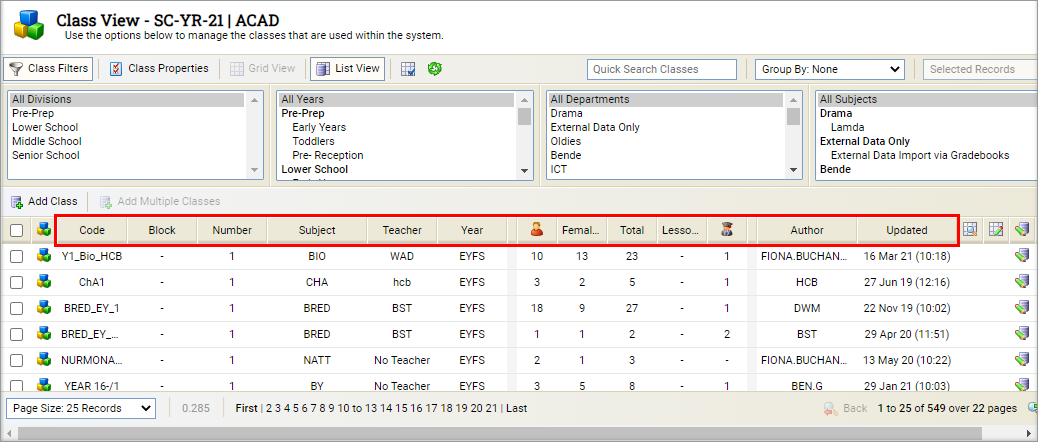
-
Choose to change the order that any of your entity selections are displayed
in the module.
- Select Order Entity xxx in your selected tab. A popup window is displayed, an example is shown below:
- Select to make a selection and use the arrows to move it up or down the list.
- Select Save & Close to close this window and return to the Edit Module Entity window.
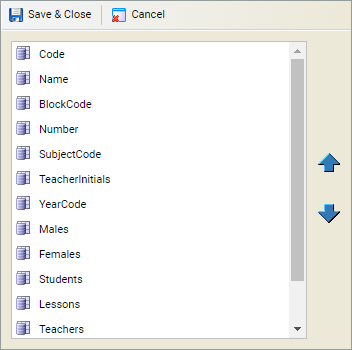
- Any changes made to entities are listed under the Audit tab in the window:
- Select Save & Close to close the Edit Module Entity window. Your preferences are displayed in the Class View screen.
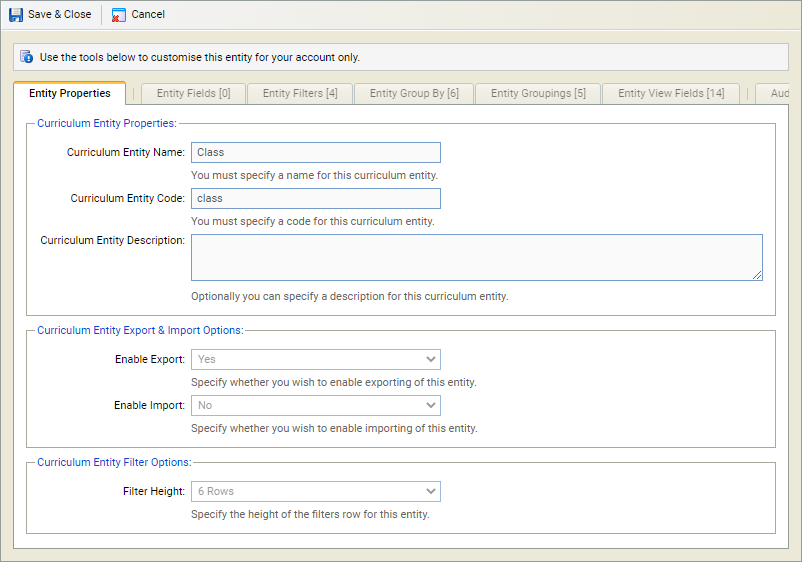
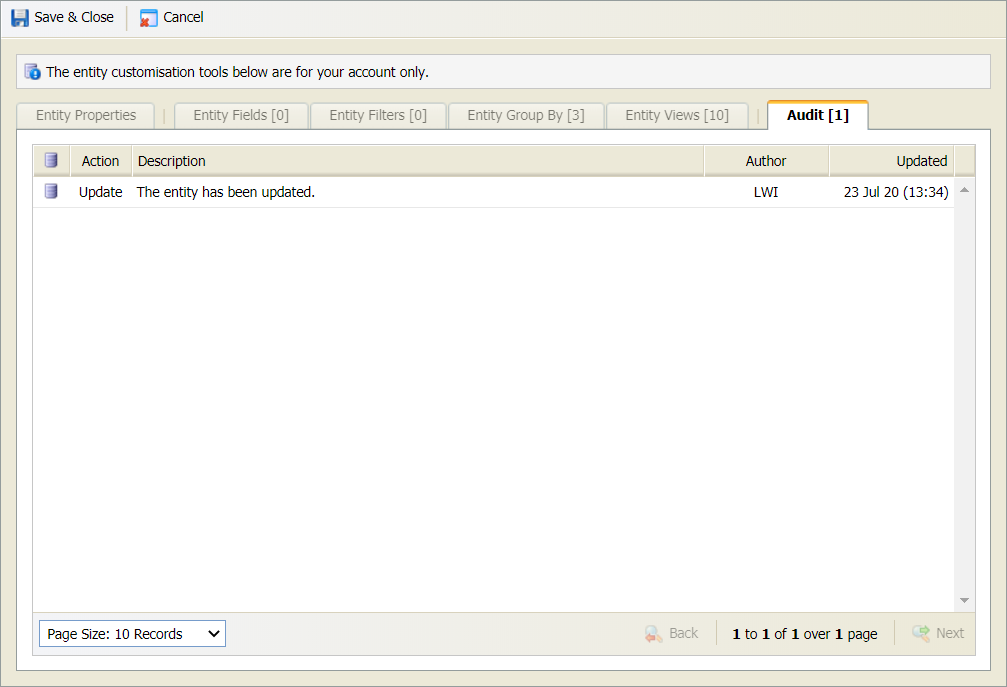
Add a class
- Select Add Course on the left of the screen. A popup window is displayed:
-
Complete the fields displayed in the Class Properties tab:
Section Explanation Class Properties Enter a clear and concise name, code and description for the class.
Class Options (1) Use the drop downs to select the:
- Class Cycle. This is prepopulated with the cycle that you have chosen to work in.
- Class Type. This is prepopulated with the programme that you have chosen to work in.
- Class Level. Academic level for this class.
- Class Course. Course for this class to sit within. The selections available are determined by the courses linked to the academic level selected above.
- Class Course Schedule. Schedule for this class. The selections available are determined by the schedules linked to the course selected above.
Class Options (2) Use the drop downs to select the:
- Class Block/Class Block Scheduling. This links to the class timetable and determines when the class meets.
- Class Number. This can act as a useful filtering tool.
- Class Room. The selections available are pulled in from the Estates Manager module.
-
Class Scheduling Plan.
- 'Group'. Students in this class, meet as a group and this class is timetabled as a group.
- 'Individual'. Timetables are individually made for each student. This is useful for single student lessons.
- Class Code. This is automatically generated. Amend if required.
- Work through the Subjects, Teachers and Years tabs to select the class subjects, teachers and year groups to associate with the class.
- Use the Add Students tab to add students to the class:
- Use the filters to select the groups of students that you want to work with. Filters are preselected according to the class level and year groups you have selected in the previous tabs. You can select other options in the filters as required.
- Use the navigation tools at the bottom of the window as required.
- Use the checkboxes on the left to select students.
- Select Save & Close. The new course is displayed in the Class View screen.
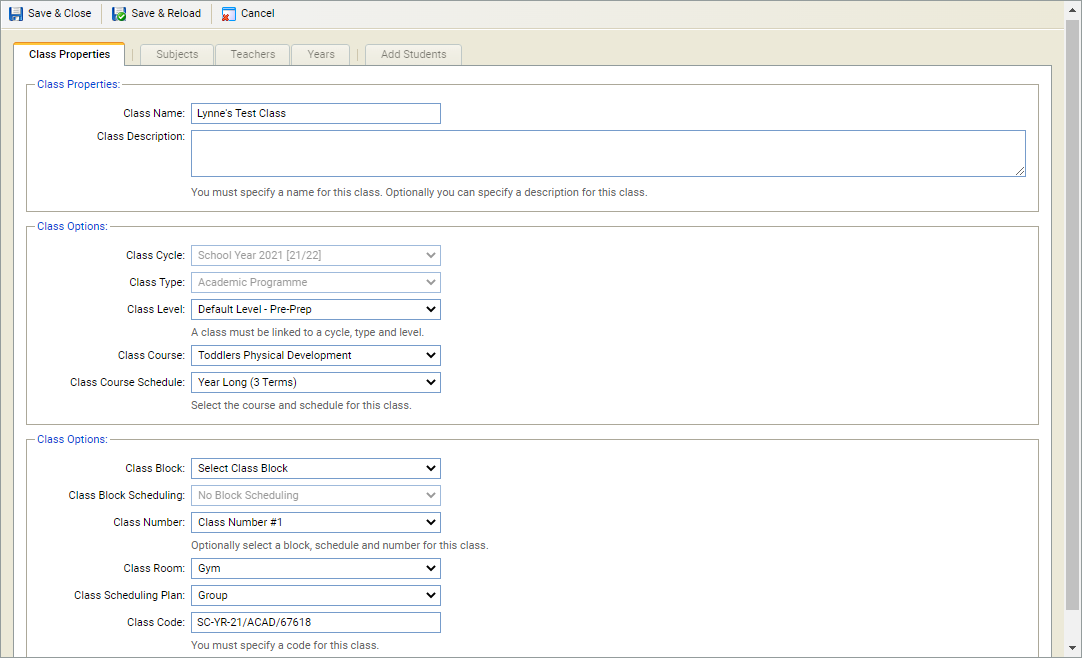
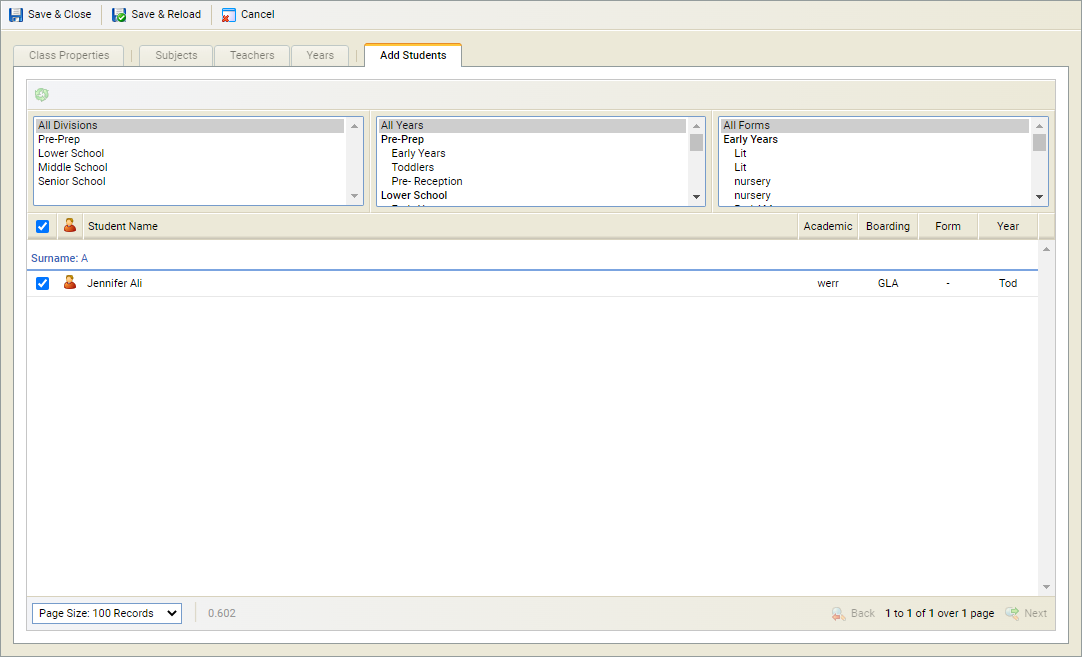
Copy a class
Choose to copy either the outline of a class with all the selected entities or a complete class including all students and teachers.
- Use the checkboxes on the left to select the classes that you want to copy.
-
Open the drop-down in the top right and select either:
- Empty Copy Classes. Copies just the class outlines.
- Full Copy Classes. Copies all class detail, including students and teachers.
- Confirm your selection in the popup window displayed.
- The copied classes are displayed.
Edit a class
Update the details of a class if required. For example, update the students listed for a class.
-
Scroll to the course that you want to edit and click the edit icon. A popup window is displayed:
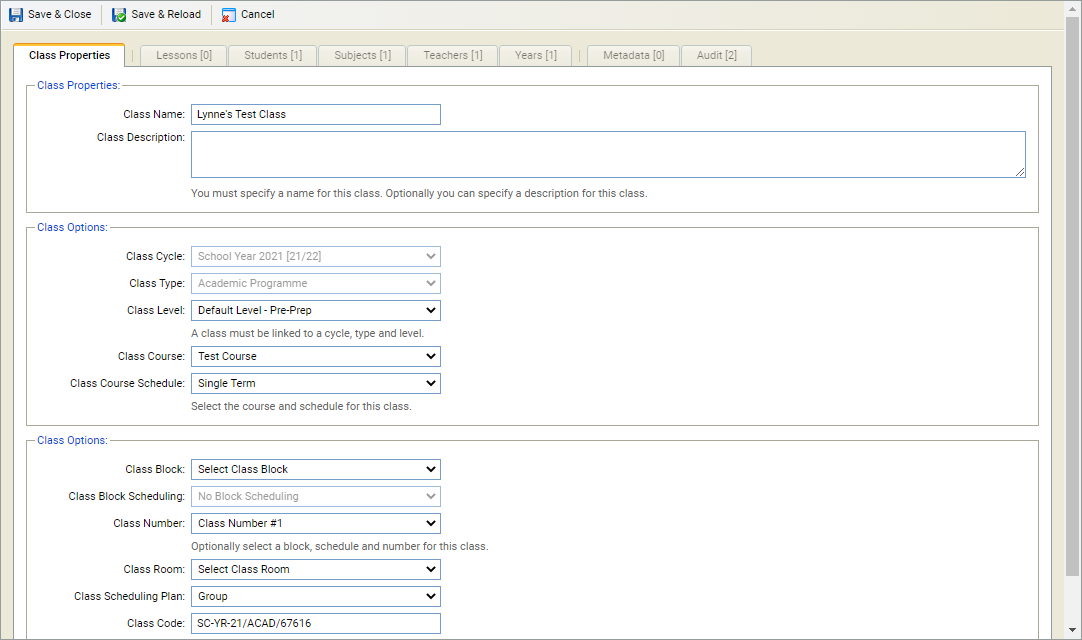
-
Complete the fields displayed in the Class Properties tab:
Section Explanation Class Properties Enter a clear and concise name, code and description for the class.
Class Options (1) Use the drop downs to select the:
- Class Cycle. This is prepopulated with the cycle that you have chosen to work in.
- Class Type. This is prepopulated with the programme that you have chosen to work in.
- Class Level. Academic level for this class.
- Class Course. Course for this class to sit within. The selections available are determined by the courses linked to the academic level selected above.
- Class Course Schedule. Schedule for this class. The selections available are determined by the schedules linked to the course selected above.
Class Options (2) Use the drop downs to select the:
- Class Block/Class Block Scheduling. This links to the class timetable and determines when the class meets.
- Class Number. This can act as a useful filtering tool.
- Class Room. The selections available are pulled in from the Estates Manager module.
-
Class Scheduling Plan. This cannot be amended.
- 'Group'. Students in this class, meet as a group and this class is timetabled as a group.
- 'Individual'. Timetables are individually made for each student. This is useful for single student lessons.
- Class Code. This is automatically generated. Amend if required.
- The Lessons tab is in development.
- Use the Students tab to review the students within the class. You can also add, edit or remove students to and from the class from here:
- Use the filters and Group By function to view the groups of students that you want to work with.
- See Student View for more help with working with class students.
- Work through the Subjects, Teachers and Years tabs to select the class subjects, teachers and year groups to associate with the class.
-
Two other tabs are available, these are explained as follows:
- Metadata. Any metadata fields set up for classes are listed here. Add values for the metadata fields as required.
- Audit. Any changes made to the class are listed here.
- Select Save & Close. The amended class is listed.
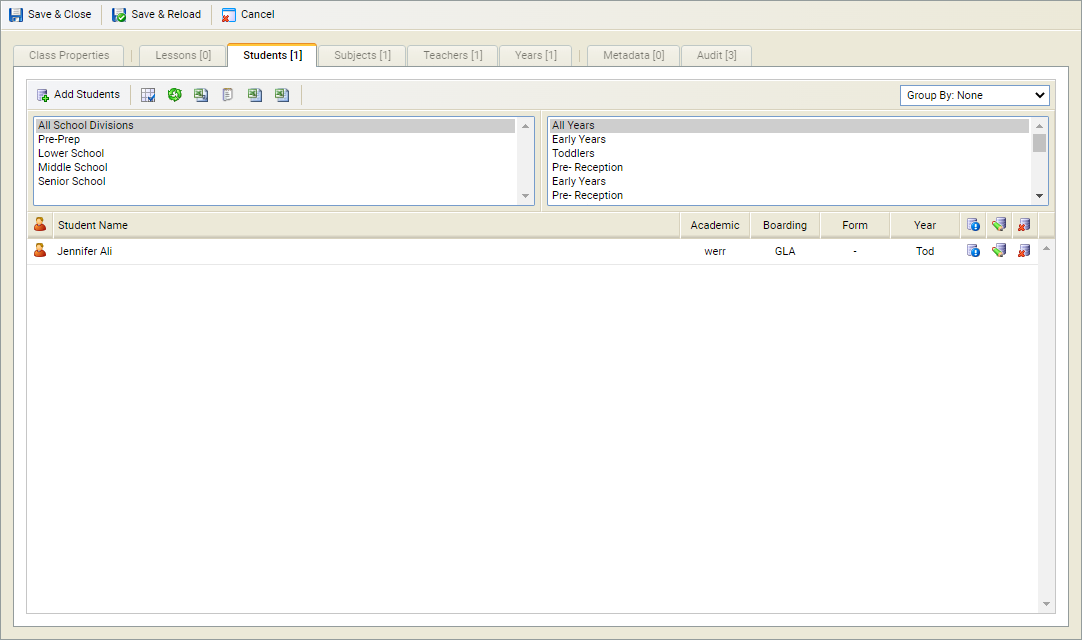
Delete a class
Remove a class that has been added in error.
- Scroll to the class that you want to delete and click the delete icon. You are prompted Are you sure you want to delete this class?
- Select Yes.
- The class is removed. A log is kept under the Logging tab for auditing purposes.
